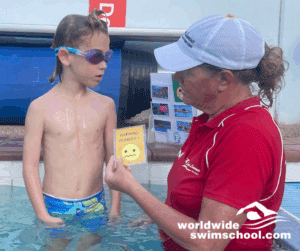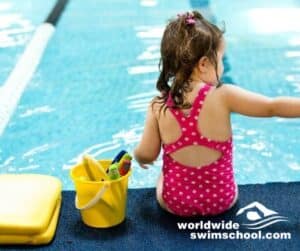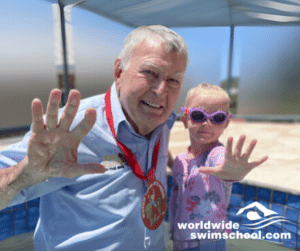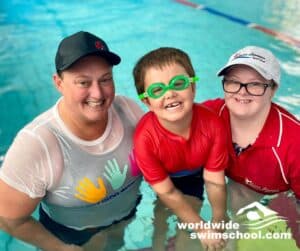The baby swim program starts at home in the bath tub. Here, the dedicated loving parents can introduce their baby to the water in a relaxed, controlled and secure environment. These early experiences in the bath should be designed to stimulate baby’s senses, introduce them to the fun floating sensation and prepare them for their first underwater experience outside the womb. Parents must never leave their baby unattended in the bath and must stay within arms reach at all times.
When to Start a Baby in a Swim Program
Somewhere between four and six months is the ideal time to introduce your baby to the pool and formal learn-to-swim lessons. At four months the baby has good neck control, they are becoming interested in new surrounds and the parent is more relaxed interacting with their baby. When introducing baby to the pool it is important that the environment is safe and appropriate for young babies.
Having warm water is extremely important when teaching babies to swim as this allows them to be comfortable. The ideal water temperature is 32 degrees Celsius. If warm water is not available parents should look to utilise bathtub techniques, pick warm parts of the day, dress baby appropriately, keep baby moving, hold them close and stay in the pool for short periods of time. Parents should always be alert for the chill factor even if the water temperature is warm as an outside breeze can make it uncomfortable for your baby.
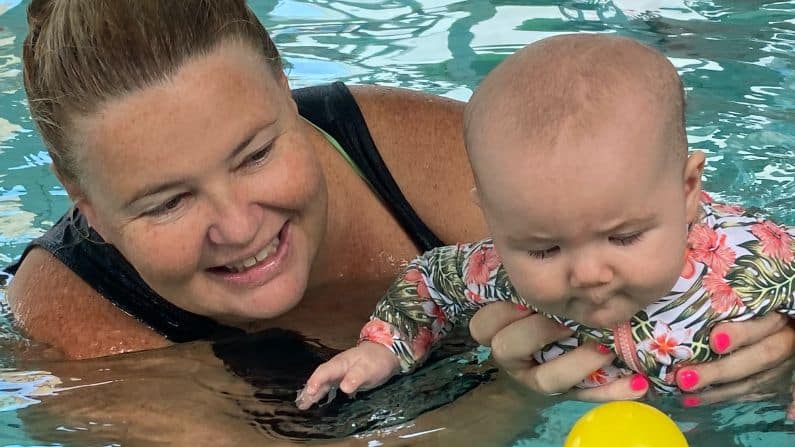
Pool Depth in Baby Swim Program
Pool depth is very important for both parent and baby. Chest level on an adult is perfect. Here the parent is able to hold the child comfortably and look them directly in the eye. Eye contact gives the baby a feeling of real security. If the water is too shallow it is difficult to maintain eye contact with the baby. If the water is too deep it can become dangerous. Parents must be able to stand and should never be trending water when teaching baby to swim. Parents can become easily fatigued when treading water and this could put your baby in danger.
The way the parent holds the baby in the water is extremely important. In every hold parents should aim to have eye contact with their baby, hold them softly so they can move freely and position them low in the water so they can feel buoyancy. The horizontal floating hold is perhaps the most important for teaching swimming because this is the hold that we use when we submerge and free float baby. Remember baby must master conditioning before parents attempt any submersions. When going underwater this horizontal position allows water to break on the baby’s forehead and run easily and smoothly over the baby’s body. To get a horizontal position parents should spread both hands under baby’s chest with the thumbs resting on the shoulders.
Parents Should Encourage Independence
We encourage parents to wear a t-shirt in the pool during learn-to-swim lessons. Wearing a loose fitted t-shirt in the water will give your baby something to grip and hold on to. This is very important for encouraging independence in the baby. Even from a very early age we can encourage baby to grip and hold on. By maintain the baby’s natural grasp reflex we can build their independence and self confidence. Independence may one day save your baby’s life.
Although we regard water as the main stimulant, it is important that you are equipped with other items to make your child’s swimming lesson stimulating and fun. Keep in mind we want to continue educating your baby via their senses specifically sight, sound and touch. Toys should have a swimming related purpose. Large colourful balls are perfect for babies to chase when doing floating and kicking activities. Balls of different colours and textures will increase stimulation. Pouring water from a can will also excite and stimulate baby’s touch sense and help make them calm and relaxed. Plastic cups are important as they allow us to condition baby for submersion.
Breath Control
Conditioning teaches baby breath control on command. Here we prepare baby for their first underwater experience by conditioning them to react and hold their breath in response to the verbal conditioning trigger, “name, ready go”. To condition baby we sit them upright. Take a full cup of water. Use the verbal trigger, “name, ready go”.
Pour the full cup on the baby’s forehead. When conditioning we want the water to run quickly, smoothly and evenly down the forehead so that baby does not ingest any water. Parents should practice conditioning at home in the bath tub and during the swimming lesson. With daily practice baby will soon master breath control on command and be ready for their first underwater experience outside the womb.
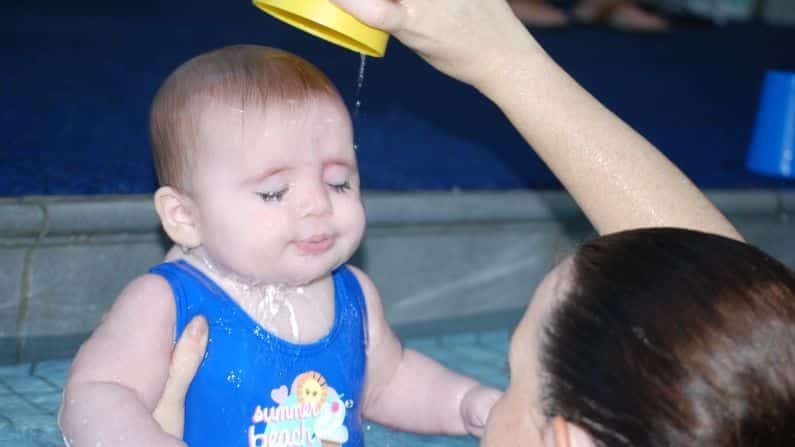
Conditioning
Parents and teachers will know the baby is ready for submersion once they show positive signs to conditioning. The baby will be happy and confident with water on the face and the parent should observe the baby holding their breath and closing their eyes on the trigger words. It is irresponsible and dangerous to submerge baby before they must have mastered conditioning. Conditioning will ensure that the baby’s first underwater experience is free from fuss or trauma.
Remember we want to instill in baby a love and respect for the water not fear or trauma. Parents must never submerge a crying baby and should only attempt this activity if they are relaxed and comfortable.
First Submersion
First submersions must be performed in a horizontal positioning. This horizontal position allows the water to break on the forehead and run smoothly and evenly over the body. Submerging in a vertical position allows the water to be easily forced up the baby’s nose. When submerging baby we use a double trigger. We continue with our verbal trigger, “name, ready go” and follow it with a kinaesthetic lifting trigger. This lift gives the baby an opportunity to catch their breath before being taken under water. After each submersion parents should look baby in the eye, smile and congratulate their success. If baby cries or ingests water stop submersions and return to conditioning.
Fun for Parent and Child
The most important thing to remember when teaching your baby to swim is that it must be fun for both parent and child. Force has not place in the learn to swim lesson. Any programs that forces babies while they are crying and in distress must be avoided. When choosing a swim school for your baby visit multiple centres in your area so that they can compare the philosophies and overall quality of the program. Choose programs that have small class ratios, group babies according to their development, encourage parental involvement and hold national accreditation with Swim Australia and AUSTSWIM.
To find out more about what we do, get our latest release blogs, videos join our community today.
Our parent teach at home video pack is a great resource for all parents.


